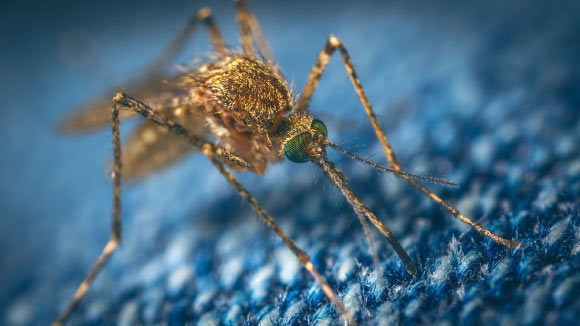Yellow fever mosquitoes (Aedes aegypti) can use their antennae to detect sounds that are at least 32 feet (10 m) away, according to a new study published in the journal Current Biology.
Mosquitoes have been known to use a variety of senses to detect the presence of potential mates and food sources. They can see, smell and most importantly hear what is around them.
However, it was previously believed that their hearing capabilities would be limited.
“It’s been known for quite a long time that male mosquitoes are drawn to the sound of the female’s beating wings,” said Cornell University’s Professor Ron Hoy, senior author of the study.
“We noted that since mosquitoes mate in mid-air, the sound of the female’s wings buzzing sets the males in motion.”
“Previous experiments to prove that males are drawn to the sounds of females in flight were done at close range, which reinforced the idea that they only hear at close range — up to one foot (30 cm).”
Past studies by Professor Hoy and co-authors to prove hearing in jumping spiders gave them the methods and skills needed to tap the auditory nerves of mosquitoes, and record the electrical potential of the excited nerves.
Initial tests in the lab revealed that auditory nerves of Aedes aegypti mosquitoes picked up sounds from across a room.
To prove this principle, the researchers set up an experiment in a field house with a 100-foot (30 m) ceiling that would reduce echoes.
They fitted mosquitoes with an electrode in their brains and made neurophysiological recordings of the auditory nerve being stimulated by pure-tones emitted from a loudspeaker 32 feet away.
“They’re hearing at distances that normally require ear drums, but these are hairs,” Professor Hoy said.
“Ear drums work by picking up pressure from sound waves, while tiny hairs sense sound from air particles vibrating at certain frequencies.”
The team then moved the nerve physiology equipment to a super-quiet anechoic room.
“We found the sweet spot of frequency that the mosquitoes are sensitive to was between 150 to 500 Hz (hertz),” said study first author Dr. Gil Menda, a postdoctoral researcher at Cornell University.
The scientists played back the tones of females’ wings beating, which occurs at a frequency of about 400 Hz.
In behavioral experiments, when these 400-Hz tones were played from as far as 10 feet (3 m) away, male mosquitoes in a mesh cage all instantly took to flight. The behavioral reaction was proved in individuals, to make sure they weren’t taking flight as part of a group response.
The mosquitoes’ frequency range for hearing also overlapped with human speech.
“The most energetic frequencies of an average human vowel is in the range of 150 to 900 Hz, so they should be able to hear people speaking,” Professor Hoy said.
“Also, using the anechoic room, we showed the sensitivity of the male mosquito was so low that when we played a tone, it was hard for us to hear it, but we can see the mosquito can hear it,” Dr. Menda said.
The study authors recorded excited auditory nerves at 30 dB (decibels). Human speech is typically spoken at 45 to 70 dB, also within the mosquito’s sweet spot.
“We were able to observe the behavior of male mosquitoes to recorded sounds of either male or female mosquitoes,” said study co-author Professor Ron Miles, of Binghamton University.
“When the sounds from male mosquitoes were played, the males mostly just sat there. But, when we played the sounds of females, the males took off flying.”
“We were also able to measure the neural response of their antennae and found they can hear sounds from surprisingly far away in the same frequencies that are important for human speech.”
“While our study provides both neurophysiological and behavioral evidence that male mosquitoes hear sounds from far field, it offers no proof that they use it to home in on people. The insects are known to pick up sensory cues such as carbon dioxide, odors and warmth to locate people. But the results do show an intriguing correlation,” Professor Hoy said.
_____
Gil Menda et al. The Long and Short of Hearing in the Mosquito Aedes aegypti. Current Biology, published online February 7, 2019; doi: 10.1016/j.cub.2019.01.026








